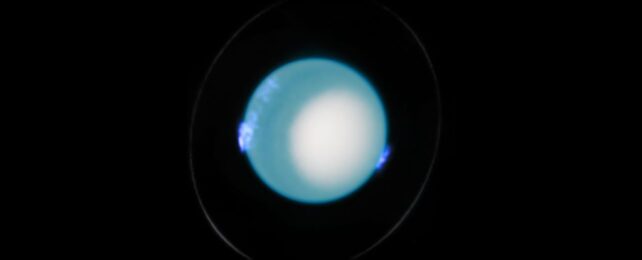New observations have revealed that we were wrong about the length of a day on Uranus.
According to the most precise measurements yet of the stinky planet's rotation rate, a full day on Uranus lasts 17 hours, 14 minutes, and 52 seconds. That's 28 whole seconds longer than we thought, based on data collected by Voyager 2 on its Uranus flyby in 1986.
That might not seem like a big deal… but it is actually huge.
"Our measurement not only provides an essential reference for the planetary science community but also resolves a long-standing issue: previous coordinate systems based on outdated rotation periods quickly became inaccurate, making it impossible to track Uranus' magnetic poles over time," explains astrophysicist Laurent Lamy of the Paris Observatory.
Uranus and Neptune are the two outermost worlds of the Solar System, at significantly greater distances from the Sun than the rest of the planets. Uranus is twice the orbital distance of Saturn; Neptune is more than three times Saturn's orbital distance.
Because they are so far, Uranus and Neptune appear small and dim, which makes them difficult to study; in addition, that distance makes them a longer trek for spacecraft, so only the Voyager mission has been close, decades ago.
This means the information we have about the outer Solar System's ice giants is limited, and may potentially be biased by the particular conditions affecting the planets at the time of the flybys. Getting new information, on the other hand, is a bit of a challenge.
The inaccuracy in our assumption about the length of the Uranian day has resulted in some confusion. One of the biggest problems was that, without an accurate length-of-day, the orientation of Uranus's magnetic poles was lost just a few years after the Voyager 2 flyby.
To remeasure the length of a Uranus day, Lamy and his colleagues made a careful study of data collected by the Hubble Space Telescope between 2011 and 2022. In that timespan, the telescope repeatedly observed the planet's ultraviolet auroras, which are generated a lot like the aurora here on Earth.
Particles borne on the solar wind smack into the planetary magnetosphere, and are whisked away and accelerated along the lines of the magnetic field to the polar latitudes, where they are dumped into the upper atmosphere. Interactions between particles in the atmosphere and the incoming solar particles make a glow in the sky.
One of the funny things about Uranus is that its rotational axis is almost parallel to the ecliptic, the orbital plane on which the planets all more or less move around the Sun, compared to the almost-perpendicular orientation of the rest of the planets. This orientation has made its magnetic poles a little harder to find.
By tracking the ultraviolet auroras, Lamy and his colleagues were able to locate and trace the poles, and used that information to precisely measure the length of the Uranian day.
This measurement is p-r-e-c-i-s-e – the most precise yet for a giant planet, the researchers say, even more precise than measurements of Jupiter's rotation rate. The technique used to measure the rate can thus be applied to the rest of the giant worlds in the Solar System to obtain precise measurements of their inner rotation rates.
"With this new longitude system, we can now compare auroral observations spanning nearly 40 years and even plan for the upcoming Uranus mission," Lamy says.
The research has been published in Nature Astronomy.
